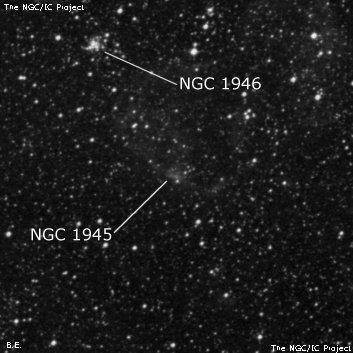
John Herschel discovered NGC 1945 = h2851 on 3 Jan 1837 and reported "eeF, vvL. Great blotches of diffused nebulosity." I logged a small, brighter patch of nebulosity on the south side of a large annular ring or loop of nebulosity. Herschel's description implies a much larger object than I described, though his position is an excellent match with this patch. I'd be surprised if he picked up the entire loop so perhaps the richness of the star field mimicked "diffused nebulosity". See Harold Corwin's notes on this number.
Karl Henize in the 1956 "Catalogues of Hydrogen Alpha Emission Stars and Nebulae in the Magellanic Clouds" (ApJS 2, p315), notes his object LHa N120-48 "includes NGC 1945." LHa N120-48 measures 12.3' east-west and 15.2' north-south. It has a slightly irregular outline, is very elongated and shows appreciable structure. LHa N120-48E (33" x 36", somewhat irregular outline, considerably elongated) lies at the centre of NGC 1945.
600/800mm - 24" (11/18/12 - Magellan Observatory, Australia): at 200x unfiltered, this LMC HII region (N48E) appeared fairly faint, fairly small, ~30" diameter. The shape is irregular and brighter along the south edge. NGC 1946 lies 4.4' NE. Several mag 11-13 stars are in the field to the northwest and these seem to stream 10' to the northeast direction, heading towards NGC 1948, a magnificent star cloud and HII complex. NGC 1951, a bright cluster, lies 11' SE and NGC 1941 is 12' NW. These objects are located on the west side of the huge LMC-4 Superbubble.
Notes by Steve Gottlieb